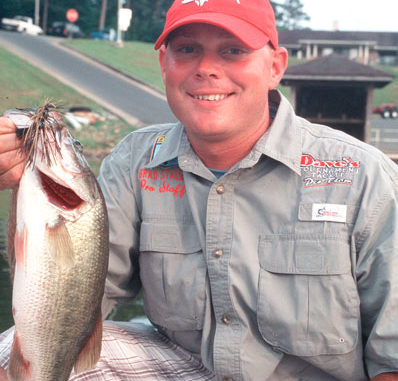
Asheboro’s Lake Reese is a great place to learn to fish offshore structure for bass.
Brad Staley of Pleasant Garden doesn’t claim to be a professional tutor, but he has sufficient evidence to support his claim that little-known Lake Reese provides a favorable environment for learning about offshore structure fishing. “For inexperienced fishermen who want to learn to do the crankbait thing and how to fish deep structure and pattern a lake but don’t want to start their training on big, crowded waters with lots of fishing pressure like High Rock Lake, Lake Reese is an excellent ‘learning lake,’” said Staley, 29, who has been wetting a hook regularly at Reese since his high-school days.
According to Staley, Lake Reese, located at 4850 Jackson Creek Rd. in Randolph County, fishes much like High Rock, a noted bass haven for deep-water crankbait fishermen. At only 900 acres, Lake Reese is less intimidating than High Rock and has less boat traffic and fishing pressure.
The lake’s smaller size, distinct river channel and abundance of offshore structure make learning the how-to’s of offshore fishing more feasible than getting schooled at larger waters.
Staley’s forte at Reese is fishing deep-water structure throughout the summer when crankbait and jigs come into play.
“Reese is a good structure lake (that) is shallow enough that a fisherman can follow the main river channel (the Uwharrie) and find structure, a process not easily done at larger lakes,” said Staley. “It’s also small in size, which makes it possible to find subtle areas where the main channel swings near spawning pockets.
“When a fisherman locates some rocks or stumps at those channel bends, he can really load up on bass. One day, the bass will favor rocks; another day, they’ll favor stumps. With some experimenting, a fisherman can figure it out.”
Staley targets such areas in eight to 16 feet of water and lets water clarity dictate whether or not he fishes the shallower or deeper depths of that strike zone.
If the water is clear, Staley fishes deeper; if it’s dingy, he fishes shallower, selecting his baits accordingly.
Reese also resembles High Rock with respect to water clarity. With heavy rains, the lake can turn dirty, especially its upper reaches. Reese fluctuates like High Rock, too. Given a dry spell, the lake level can drop four to six feet.
“In August, the lake can be closed to fishing because low water makes boating hazardous,” Staley said. “It’s best to call the lake warden’s office in advance to find out if the lake is open should there be a dry spell.”
For deep-water cranking, Staley’s lure arsenal includes Fat Free Shads, Zoom Taps and Series 5 or 6 Strike King crankbaits.
“For fishing water 10 feet deep or less, the Zoom Tap is one of the most effective baits,” Staley said. “For depths over 10 feet, other deep-diving crankbaits should be used.”
For slow presentations along deep structure, Staley uses a half-ounce Dave’s Tournament Tackle football jig in chameleon/purple with a plastic trailer. He also drags a Zoom Ol’ Monster worm along the bottom.
Unlike High Rock, Reese does not have many underwater humps or high spots. Staley said he’s aware of two such places, both marked by buoys and both good fishing holes where they drop off into deeper water. One is located about mid-lake on the left as you leave the launch site; the other is near the Boy Scout camp upriver on the right.
The Boy Scout camp is one of the few distinct landmarks on the lake, since Reese is largely undeveloped — with only a few houses marking its shoreline.
“The main creek channel and the smaller creek channels are the most significant features,” Staley said. “Find where a smaller creek channel intersects with the main channel and add some rocks or stumps, and you’ve found a gold mine for bass.
“It’s not unusual to catch several fish from one spot. The fish school frequently at Reese.”
For offshore fishing endeavors, a contour map is a fisherman’s best friend. Gemini Maps of Charlotte once published a topographical map of Lake Reese, which Staley views as excellent.
“It’s a detailed map showing the main structure and lake contours,” said Staley. “It’s the only map of Reese I’ve found. It’s hard to get a detailed map of most city lakes.”
The Gemini map is sold at the lake office.
Lake Reese anglers employ the same strategy used by High Rock fishermen once the action slows along the main lake during the dog days of summer. They head upriver, where current and baitfish often trigger some bites.
When the main-lake bite wanes, Staley fishes upriver beyond the Boy Scout camp and the US 64 bridge, where the river enters the lake. Navigating these backwaters can be treacherous.
“Once you reach the Boy Scout camp, the waters beyond are shallow, with numerous flats,” Staley said. “There are two channels upriver, but staying in them is difficult. When I reach the Boy Scout camp, I idle the rest of the way. The lake’s small, so I can get where I want in a short period of time and save the motor at the back of my boat as well.”
Beyond the US 64 bridge, the river narrows, and Staley fishes any visible cover along the bank — tree laps, brush, rock, or stumps —with shallow-running crankbaits, spinnerbaits, or flipping jigs.
“The fishing is either very good or very poor upriver,” Staley said. “When it’s good, I’ll notice baitfish throughout the stretch.”
Anglers at Reese not only learn how to fish a “miniature High Rock,” but they also get a lesson on how to fish mountain lakes like Badin, which fishes differently from High Rock — even though both are Yadkin River lakes. Badin features steep, rocky terrain; High Rock is situated mostly in shallow, rolling farmland.
The lower end of Reese near the launch site and dam drops off sharply into deep, clear water much like Badin. In this area, Shaky-head jigs and finesse baits work best.
Reese shares one other significant characteristic with High Rock: it’s loaded with bass — on the average larger than at High Rock, which rarely produces fish weighing 10 pounds or more. Staley said Reese yields at least a half-dozen or dozen 10-pound fish every year.
“There are some toads in the lake,” said Staley. “During one summer outing, Jeff Jackson of Randleman and I caught five bass weighing more than 26 pounds. That’s strong at any lake.”
Corey Oakley, a fisheries biologist for the N.C. Wildlife Resources Commission, said survey data also indicates that Lake Reese is a quality bass fishery.
“We just assessed the largemouth bass population (in 2009),” said Oakley. “The population overall has great balance, with abundant fish in all size classes. The fish are in good condition, and I would consider the lake one of the better lakes for largemouth bass in (the Piedmont).”
The City Lakes Fishing Guide of North Carolina, issued by the Commission, applauds the bass fishing at Reese as well.
“Bass fishing is superb in the spring, but catch lunkers in the summer on Carolina rigs,” the publication advised.
Reese differs from High Rock and Badin in one important respect — no personal watercraft or recreational boats are allowed. The only other boats fishermen will encounter are other fishing boats and an occasional kayak or canoe. There’s no high-speed boating at the lake, either. The maximum boat speed is 25 mph.
Lake Reese provides a peaceful learning venue for the inexperienced fishermen and a great fishing hole for the experienced angler. The fishing at Reese attests to the old saying, “That the best gifts come in small
packages.”

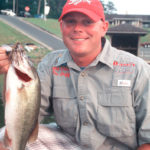
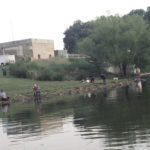
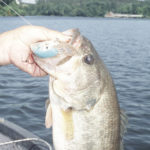
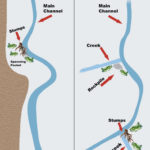
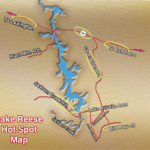


Be the first to comment